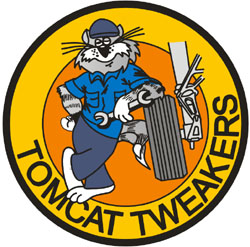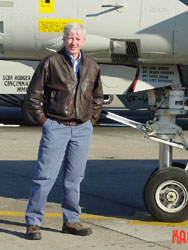
|
The Tomcat Tweaker
With the impending end of the Tomcat era in naval aviation there is something to be said that has been overlooked by just about everyone that writes of the Tomcat's tremendous career and awesome reputation. While it is true that the pilots and RIOs who flew them were responsible for ensuring that the mission was successful and objectives completed…none of it would have been possible without the efforts of the nineteen and twenty year old kids that put their hearts and souls, and often their blood into making the Tomcat the incredible machine that it was. The maintenance men and women that kept the F-14 mission ready. You have to admire the people that day in and day out spent 10 to 18 hours a day servicing and inspecting, tweaking and adjusting, cleaning and painting, riveting and bending, splicing and safety wiring to make things right for the aircrew that will strap the jet on for the next event. They did it with determination and grit, expecting nothing but another day of doing the same thing. Who can forget the line rat, the youngest and probably least appreciated of them all. Always there, always working, rain or shine. If the jets were flying they were working. Or the plane captains who always had the jet set up just the way it was supposed to be and were there faithfully when the jet came back to begin the process all over again. The troubleshooter/ final checker with the tool pouch strapped to their hip who was always vigilant for the unexpected hydraulic leak or control surfaced that didn't operate just right or the multitude of other things that could end a mission before it started. Then there is the electrician who made the signature wing sweep system operate at it's very best and rolled up his sleeves and grabbed a meter whenever there was a problem in the miles of wiring that had to maintained. There was the IWT tech, always up to his ears in parts, trying to keep the radar the most feared detection and guidance system in the air. The airframer trying to stay ahead of the leaks and keep an old and tired, but ultimately incredible, airframe patched together and flyable. Also the AME who maintained the environmental and life support systems and were responsible for saving dozens of aircrews when they had to take a Martin-Baker rocket ride from a stricken warrior. Finally the mechs, who kept the cantankerous TF-30 trimmed and reliable, and the awesome F-110 at the top of its form. These are the people that made the Tomcat what it was. Looking back on twenty four years of maintaining Tomcats I am amazed at the resiliency of the people that I worked with. The determination to get the job done whatever it took and however long it took. When the rest of the air wing had put their jets to bed for the night the Tomcat guys were still hard at it. I remember young men and women pushing the nitrogen cart from one end of the flight deck to the other all night long to service systems. Putting the Jenny on one aircraft after another to check systems. Carrying tie down chains over the shoulders and chocks in both hands chasing jets around the deck while the yellow shirts decided where to park them. Hopping from this jet to the next for maintenance turns. Twenty hour shifts to change the four-way valve so we could fly off the next morning and go home. Rushing parts from the hangar deck to the flight deck to make a go that couldn't be missed. Troubleshooting and changing parts on the way to the cat. Chasing broken wires and illusive short circuits to the most inaccessible places you can imagine. The sometimes near super-human efforts to turn around broken jets for the next event. Working in the scorching sun of the Arabian Sea and freezing rain and snow of the North Atlantic. Thousands of hours of frustration, hundreds of hours of anxiety and stress. All for a few seconds of joy and awe when you see the jet that you just fixed light the burners and take the cat stoke. It was all worth every minute of it. There is no way to describe the pure satisfaction I have at being a part of all of it. There are no thousand hour or centurian patches or fancy flight jackets to go with the job and validate what you do. No headline news stories when things go right and lots of visibility when things go wrong. Just the knowledge that if it wasn't for you, all of that wouldn't have been possible for them.  Along the way there were hundreds of people who played parts in making my career what it was and continues to be. The maintenance chiefs and Grumman technicians that allowed me to be creative and think out of the box when things got tough and answers were needed. The people who taught me the ins and outs of being a top notch maintenance technician and teacher. Joel Hotchkiss and Bob Graham from the Phantom days. Bob Powell and Dave Jones my supervisors and friends in VF-102. Bob Gunby, Charlie Mayfield, George Nichols, George Leed and Nat Young of Grumman. Jimmy Barnes and Josh Beers from NATEC. The dozens of maintenance chiefs that I was privileged to work with through the years. The shop supervisors and worker bees that I spent years with tinkering and tweaking and learning. You know who you are. Thank you. I am honored to have been part of your world.
Along the way there were hundreds of people who played parts in making my career what it was and continues to be. The maintenance chiefs and Grumman technicians that allowed me to be creative and think out of the box when things got tough and answers were needed. The people who taught me the ins and outs of being a top notch maintenance technician and teacher. Joel Hotchkiss and Bob Graham from the Phantom days. Bob Powell and Dave Jones my supervisors and friends in VF-102. Bob Gunby, Charlie Mayfield, George Nichols, George Leed and Nat Young of Grumman. Jimmy Barnes and Josh Beers from NATEC. The dozens of maintenance chiefs that I was privileged to work with through the years. The shop supervisors and worker bees that I spent years with tinkering and tweaking and learning. You know who you are. Thank you. I am honored to have been part of your world.As the last Tomcat gets ready to fly over the fence and into history remember not only the achievements of the airframe and the aircrews who flew them, remember the men and women who cared for and fed them. Remember the pure hard work and long hours. Remember the dirty and tired faces. Remember the frustration. Remember the smiles. Remember the incredible satisfaction of a job well done. Remember the Tomcat Tweaker. There will never be another like him. - Bruce Fenstermaker  Bruce Fenstermaker worked on the Tomcat from January 1982 until September 2005 until he was transferred to NAS Whidbey Island. Bruce Fenstermaker worked on the Tomcat from January 1982 until September 2005 until he was transferred to NAS Whidbey Island. While in the Navy he worked on the Tomcat in VF-102 and as an electrical systems instructor at NAMTD in Oceana. After that worked for Grumman at the field site as a Tech Rep from 1986 until 1995 on a civil service job with NAESU (now NATEC) to support the Tomcat (NATEC is a division of NAVAIR). He worked there on the Tomcat at Oceana in that capacity until he was transferred out with the last deployment of VF-31 and VF-213. |
Top of the page |
F-14 Tomcat: Other Topics: Start Page Foreword FAQ Updates Copyright © by Torsten Anft |